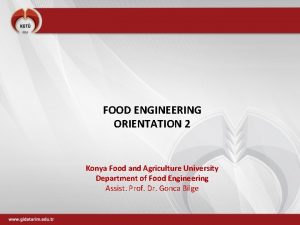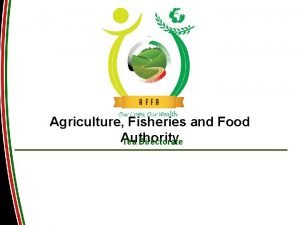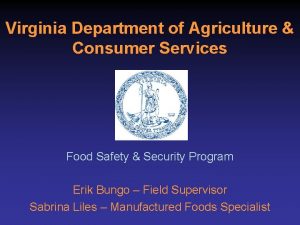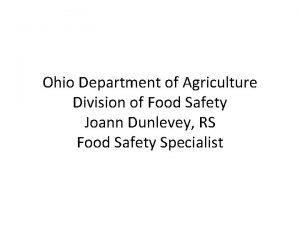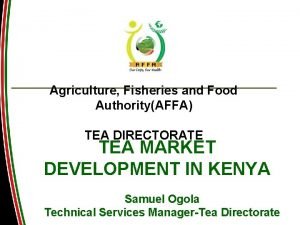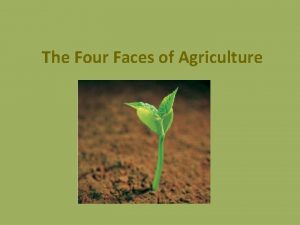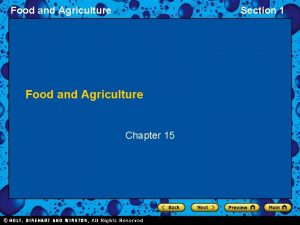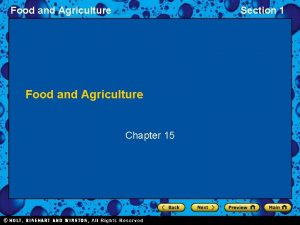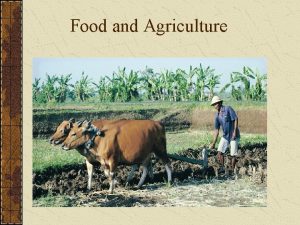The Four Faces of Agriculture Food System All
















- Slides: 16

The Four Faces of Agriculture

Food System • All the steps it takes to get food from farm to table. • These steps include: 1. 2. 3. 4. 5. 6. 7. 8. Production (on the farm) Processing Transportation Storage Marketing Preparation Consumption Disposal

Four Faces of Food • Global Industrial Agriculture • Organic Agriculture • Sustainable Agriculture • Permaculture

Industrial Agriculture © Grace Factory Farm Project

Fossil Fuels

Pros and Cons: Industrial Agriculture Pros Environment: • Can produce a lot of food Community: • Encourages trade with other countries Economy: • Offers “cheap”, convenient produce to the consumer • Transportation offers more food choices • Employs a lot of people in each sector of the system in a range of jobs Cons Environment: • Chemicals introduced to soil, water, air, other life • Dependent of fossil fuels that cause pollution • Depleting fossil fuel reserves Community: • Drives local farmers out of business • Employs migrant workers will little regard to their health and workers’ rights Economy: • Competes with local economies • Consumer dollars leave the town/state to big corporations

Organic Agriculture

The Grocery Store Wars http: //www. youtube. com/watch? v=h. Vr. Iy. Eu 6 h_E

Organic Agriculture • Silent Spring, 1962 • Organic Foods Production Act, 1990 s • USDA Organic label, 2002 • • On-farm inspections once a year by USDA No chemicals for 3 years Farm plan include IPM, crop rotations, cover crops, composting and soil improvements No antibiotics for organic livestock Organic feed for organic livestock Organic seeds and seedlings must be used, unless not commercially available No GMOs Farm records

Pros and Cons: Organic Agriculture Pros Cons Environment: • Farming practices don’t use chemicals that impact soil, air, and water. • Adds diversity to ecosystem by attracting bees, insects, birds, and animals. Community: • Better for your health Economy: • Employs a lot of people in each sector of the system in a range of jobs Environment: • Dependent of fossil fuels that cause pollution • Depleting fossil fuel reserves Community: • Drives local farmers out of business • Expensive for farmers to become certified • Lots of paperwork for busy farmers to remain certified Economy: • Competes with local economies • Consumer dollars leave the town/state to big corporations • Expensive

Sustainable Agriculture

Sustainable Agriculture • Local food system that incorporates three main goals of environmental stewardship, farm profitability, and prosperous communities. • Economy: secure living for farmers; good, affordable food for all • Environment: preserves and enhances natural resources— soil, water, air • Community: promotes cooperative relationships – CSAs, direct partnerships

Pros and Cons: Sustainable Agriculture Pros Cons Environment: • Farming practices don’t use chemicals that impact soil, air, and water. • Adds diversity to ecosystem by attracting bees, insects, birds, and animals. • Preserves local landscape Community: • Better for your health • Supports local farmers • Works to preserve character of rural communities • Enhances character of urban communities Economy: • Tries to support local processors, distributors, retailers, thereby supporting local economy Environment: • Can’t get food year-round (though eating in season can be considered a pro too, as it puts you in touch with the cycles of the natural world) Community: • ? Economy: • Expensive

Permaculture

Permaculture • Permanent Agriculture • Designing agricultural systems to mimic natural ecosystems • Ethics: – Care for the Earth – Care for the People – Sharing the Surplus 10 Design Principles: 1. Relative location 2. Multiple functions 3. Use biological resources 4. (re)cycle energy and nutrients 5. Maximize diversity

Pros and Cons: Permaculture Pros Cons Environment: • Farming practices don’t use chemicals that impact soil, air, and water. • Adds diversity to ecosystem by attracting bees, insects, birds, and animals. • Preserves local landscape Community: • Better for your health • Works to preserve character of rural communities • Enhances character of urban communities Economy: • Tries to support local processors, distributors, retailers, thereby supporting local economy Environment: • Can’t get food year-round (though eating in season can be considered a pro too, as it puts you in touch with the cycles of the natural world) Community: • ? Economy: • ?
 It has 6 faces 8 vertices and 12 edges
It has 6 faces 8 vertices and 12 edges Name all the lines name all the segments name all the rays
Name all the lines name all the segments name all the rays Flow of energy in a food chain
Flow of energy in a food chain Unit 2 food food food
Unit 2 food food food Eltonian pyramid
Eltonian pyramid Konya food and agriculture university
Konya food and agriculture university Tea directorate
Tea directorate Virginia department of agriculture food safety
Virginia department of agriculture food safety Ohio department of agriculture food safety
Ohio department of agriculture food safety Ministry of food agriculture and fisheries denmark
Ministry of food agriculture and fisheries denmark 399
399 Hình ảnh bộ gõ cơ thể búng tay
Hình ảnh bộ gõ cơ thể búng tay Ng-html
Ng-html Bổ thể
Bổ thể Tỉ lệ cơ thể trẻ em
Tỉ lệ cơ thể trẻ em Gấu đi như thế nào
Gấu đi như thế nào Chụp phim tư thế worms-breton
Chụp phim tư thế worms-breton





